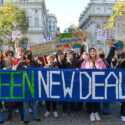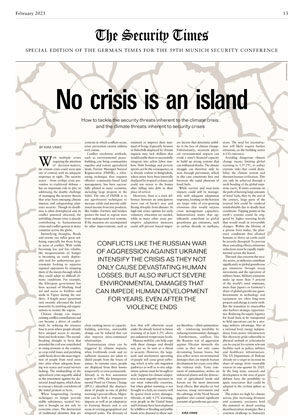No crisis is an island
 Credit: Shutterstock/Pixzoos
Credit: Shutterstock/Pixzoos How to tackle the security threats inherent to the climate crisis, and the climate threats inherent to security crises
With multiple crises requiring the attention of decision-makers, the climate crisis could soon spin out of control, with no adequate responses in sight. The security sector – from civilian crisis prevention to traditional defense – has an important role to play in addressing the double challenge of managing the security threats that arise from emerging climate impacts and safeguarding planetary security. Though its deadliness is often downplayed and its conflict potential obscured, the unfolding climate crisis is already contributing to humanitarian crises and conflict genesis in many countries across the globe.
Intensifying droughts, floods and storms can inflict great suffering, especially for those living in areas of conflict. With yields becoming less and less reliable, the weaponization of hunger is becoming an easily deployable tool for authoritarian governments looking to suppress regional opponents by stripping them of the means through which they could adapt to difficult climatic conditions. For example, the Ethiopian government has been accused of blocking food aid and access to fertilizer and seeds in Tigray during the war there. A fragile peace agreement only recently alleviated the food insecurity by enabling aid organizations to reenter the region.
Climate change can impact existing conflict constellations and can become a driver of conflict itself, by reducing the resource base in areas where people already have unequal access to income, food and fresh water. The record-breaking drought in Syria that preceded the civil war contributed to rising tensions in the country, as crop-yield losses and perishing cattle herds drove the mass migration of people from rural areas into cities where adequate housing was scarce and social services lacking. The mishandling of the agricultural crisis arguably added to the resentment against the dictatorial Assad regime, which chose to execute a bloody crackdown of the initial protests in Syria.
When longstanding farming techniques no longer provide stable subsistence, societal friction is brought on not only by economic crises. The destruction of traditional identities that are often connected to livelihoods can provide fertile ground for extremists’ recruitment strategies. For instance, marginalized Fulani pastoralists in Burkina Faso, whose herds are affected by drought conditions, have been targeted by Islamist terrorists, aiming to lure young men into their organizations. Conflicts have many causes and the factors leading to violence are often intertwined. Climatic factors influencing conflict constellations should not be analyzed in isolation from socio-economic factors. But without taking into consideration the environmental contexts in which conflicts occur, crisis prevention cannot address root causes.
Conflict resolution methods, such as environmental peacebuilding, can bring communities together and restore agricultural lands. Farmer Managed Natural Regeneration (FMNR), a reforesting technique that requires effective community-based land management, has been successfully piloted in many countries, including large projects in the Sahel. The aim of FMNR is to use agroforestry techniques to increase yields and provide additional income from tree products, like fodder. Farmers and herders protect the land to regrow trees from underground root systems. If the measures are accompanied by other improvements, such as clean cooking stoves or capacity-building activities, sustainable change can be induced that can also improve intra-communal relationships.
Humanitarian crises can be triggered by climate impacts, when livelihoods erode and no sufficient measures are taken to shield people from the forces of nature. In extreme cases, people are displaced from their homes temporarily or even permanently. Already in its first assessment report in 1990, the Intergovernmental Panel on Climate Change (IPCC) identified the displacement of people as one of global warming’s gravest effects. Migration can be both a response to impacts as well as an adaptation to looming threats and it can occur at varying geographical and temporal scales. The diversity of human mobility in the context of climate change has since been acknowledged by scientists – it also features in the 6th and latest assessment report of the IPCC.
The World Bank projects that under a pessimistic scenario more than 200 million people could be internally displaced by climate change by 2050. It is hard to imagine such a scenario without knock-on effects for transboundary migration. And while in more and more places migration is becoming the last resort to adapt to extremes, moving does not necessarily enable people to maintain or improve their standard of living. Especially farmers or fisherfolk displaced by climate impacts may lack skillsets that would enable them to successfully integrate into urban labor markets. Debt bondage and poverty spirals can be the consequence, as is already evident in Bangladesh, where many have been internally displaced by tropical cyclones and could not return to the homes after falling into debt in their place of arrival.
Moreover, there is a stark difference between an anticipatory move out of harm’s way and fleeing abruptly from disaster. In high-risk zones options for early voluntary relocation are needed, while in many other areas preemptive adaptation measures could still prevent forced migration that will otherwise occur under the already locked-in future warming of at least 1.5°C above pre-industrial temperature levels.
Human mobility can help cope with these changes and should not, per se, be seen as a threat to security. However, the large-scale and involuntary uprooting of people will cause great suffering, which is why safe migration pathways as well as in-situ adaptation options must be brought to scale. Support for climate adaptation is most urgently necessary in our most vulnerable countries, but when global warming is not brought to a halt, no country will be spared from severe damages. Already, at only 1.2°C warming, even people in the United States and Germany have been displaced by wildfires or flooding and public funds were directed to those suddenly in need.
As these different examples illustrate, physical climate impacts work their way through very diverse social and economic systems that possess differing abilities to respond and adapt to shifting weather patterns and extreme events. This is why when three countries are hit by a regional drought, two may remain stable, while the other descends into chaos. Disaster risk reduction infrastructure and preparedness, early warning systems, agricultural insurances, representation of minorities, good governance – all are factors that determine stability in the face of climate change. Unfortunately, recurrent physical environmental impacts can erode a state’s financial capacity to build up strong systems that can withstand shocks. The climate struggle can therefore only be won through prevention, which in this case constitutes first and foremost the rapid phaseout of fossil fuels.
While current and near-term impacts could still be manageable with adequate adaptation responses, looming on the horizon are larger risks of ever-growing emissions that would surpass crisis management capacities. Industrialized states that significantly contribute to global greenhouse gas emissions, such as carbon dioxide or methane, are therefore – albeit unintentionally – reinforcing instability by inducing transboundary damages.
Furthermore, conflicts like the Russian war of aggression against Ukraine intensify the crisis as they not only cause devastating human losses, but also inflict severe environmental damages that can impede human development for years, even after the violence ends. Toxic remnants of ammunition, strikes on industrial plants and the destruction of agricultural lands and forests are the most imminent local effects. But attacks on fuel reserves, troop movements and the sabotage of the Nord Stream pipelines also caused significant amounts of greenhouse gas emissions. The need for reconstruction will likely require further emissions, as the building sector is CO2-intensive.
Avoiding dangerous climate change means limiting global warming to 1.5°-2°C, to reduce extreme risks that could destabilize the climate system and threaten human civilization. This can only be achieved through a swift bending of the global emissions curve. If states continue on the path of burning large amounts of fossil fuels, then by the end of the century, large parts of the tropical belt could be rendered uninhabitable due to deadly heat conditions. Tipping points in the earth’s systems could be triggered by higher warming levels that would result in irreversible changes. Within the lifetime of a person born today, the planetary conditions that allowed humans to thrive on earth could be severely disrupted. To prevent these cascading effects, emissions reductions must be rapidly implemented across the board.
This task also concerns the security sector, as militaries contribute significantly to global greenhouse gas emissions through troop movements and the operation of military bases. Military emissions make up more than 5 percent of the world’s total emissions, more than Japan’s or Germany’s share of global greenhouse gases. Investments in technology and equipment are often long-term projects and change is rarely swift. But the transition to renewables also harbors strategic opportunities. Reducing the supply logistics for fossil fuels to be transported to field operations can be a strategic military advantage. Also at a national level, energy independence from power infrastructure like electricity grids vulnerable to physical ambush or cyberattacks can be crucial for system relevant facilities such as police, military and healthcare infrastructure. The US Department of Defense already set a target to increase its share of energy from renewable sources to one-quarter by 2025. In the long term, research and development in the area of green defense have the possibility to ignite innovation that could be adapted in the civilian sphere as well.
The stakes are high for climate action, plus increasing divisions and economic pressures hold the potential to derail existing decarbonization strategies. But a common challenge to humanity also has the potential to unlock cooperation. While progress on implementing the commitments of the landmark Paris Climate Agreement of 2015 has been slow, as more and more impacts materialize, the willingness of countries to act on climate change may increase as well – hopefully before the limits of adaptation are surpassed.
More than 30 years after the first IPCC report was published, there are no good arguments left to delay emissions mitigation in any sector. Today is the day change should commence.
Kira Vinke is head of the Center for Climate and Foreign Policy at the German Council on Foreign Relations (DGAP). She also co-chairs the Advisory Board to the German Federal Government on Civilian Crisis Prevention and Peacebuilding. Her critically acclaimed book Sturmnomaden. Wie der Klimawandel uns Menschen die Heimat raubt (Storm nomads. How climate change is robbing us of our home) was published by dtv in 2022.




